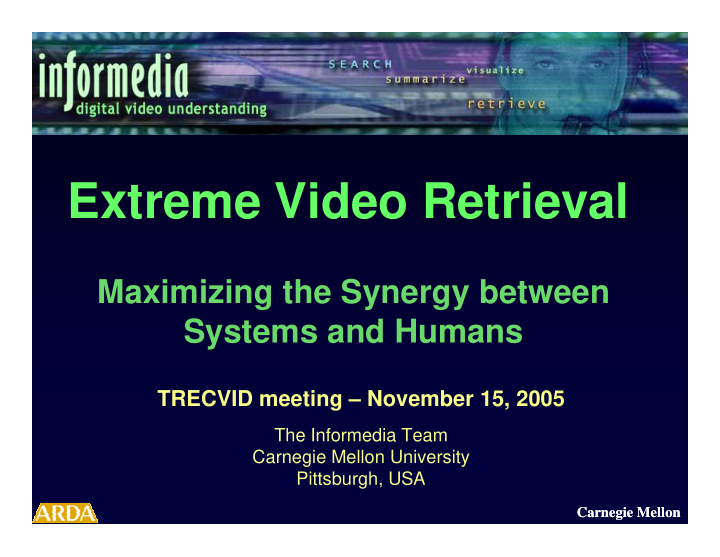



Extreme Video Retrieval Maximizing the Synergy between Systems and Humans TRECVID meeting – November 15, 2005 The Informedia Team Carnegie Mellon University Pittsburgh, USA Carnegie Mellon Carnegie Mellon
“Classic Informedia” Interface Work • Interactive Video Queries • Multilingual and fielded text query matching capabilities • Faster color-based matching with simplified interface for launching color queries • Interactive Browsing, Filtering, and Summarizing • Browsing by person-in-the-news • Browsing by visual concepts • Quick display of contents and context in synchronized views • Testing with Novice Users as well as Experts • Same questionnaires used as with TRECVID 2004 (to get satisfaction usability measure and help interpret results) • Logging to test “Extreme Light” interface supporting text, color, and concept browsing/search Carnegie Mellon Carnegie Mellon
TRECVID Evaluation Interface Example Carnegie Mellon Carnegie Mellon
Visual Browsing Carnegie Mellon Carnegie Mellon
“Classic Informedia” Results • Concept browsing and image search used much more relative to text search compared to prior TRECVIDs • Novices still have lower performance than experts (reconfirming 2004 studies, with logs of actions for follow-up analysis) • Nature of topics caused “interactive” this year to be more one-shot query, less browsing/exploration • Performance improvements not found for leveraging usage context (hiding shots judged in prior queries) • “Extreme-light” interface including concept browsing often good enough that user never proceeded on to any query • “Classic Informedia” scored highest of those testing with novice users Carnegie Mellon Carnegie Mellon
TRECVID’05 Interactive Search Results Novice Users, “Classic Informedia” Carnegie Mellon Carnegie Mellon
The Goal of Extreme Video Retrieval Exploring Video Search at the Limits of Human and System Performance A Different Approach Carnegie Mellon Carnegie Mellon
Observations about Automatic vs Interactive Search Carnegie Mellon Carnegie Mellon
Extreme Video Retrieval • Automatic retrieval baseline for ranked shot order • Two methods of presentation: User-controlled or System-controlled time interval • User-controlled Presentation – Manual Browsing with Resizing of Pages • System-controlled Presentation - Rapid Serial Visual Presentation (RSVP) Carnegie Mellon Carnegie Mellon
The Automatic System Result • Start with automatic system generated result • 5 uni-modal retrieval “experts” and 15 semantic features • Experts: Text, Color, Texture, Edge, PersonX • Features: Face, Anchor, Commercial, Studio, Graphics, Weather, Sports, Outdoor, Person, Crowd, Road, Car, Building, Motion • A relevance-based probabilistic retrieval model • Basic model: “ranking” logistic regression - Reduce the disorders between positive/negative data • Query analysis: incorporate the query information into the combination function - Five query types with combination weights learned from TREC04 • Present shots (image keyframes) in ranked order Carnegie Mellon Carnegie Mellon
XVR Automatic Baseline (Unevaluated) Automatic System Run Used as XVR Baseline 0.14 0.12 0.1 0.08 0.06 0.04 0.02 0 Carnegie Mellon Carnegie Mellon
TRECVID Manual Results 'Manual' Systems 0.18 0.16 0.14 0.12 0.1 MAP 0.08 0.06 0.04 0.02 0 Carnegie Mellon Carnegie Mellon
User-controlled presentations • Manual Browsing with Resizing of Pages • Manually page through images - User decides to view next page • Vary the number of images on a page (2, 4, 9, 16) • Allow chording on the keypad to identify shots of interest • Also tried clustering by story and without resizing of pages • Not as effective • A very brief final verification step (1 min) Carnegie Mellon Carnegie Mellon
MBRP - Manual Browsing with Resizable Pages Carnegie Mellon Carnegie Mellon
System-controlled Presentation • Rapid Serial Visual Presentation (RSVP) • Minimizes eye movements - All images in same location • Maximizes information transfer: System � Human - Up to 10 key images/second - 1 or 2 images per page - Presentation intervals are dynamically adjustable by the user • Slower initially (or when “breaks” are needed) • Many relevant images, user needs habituation • Faster after a few minutes (100 msec/page increments) • Few relevant images, accommodation • Click when relevant shot is seen - Mark previous page also as relevant • A final verification step (~3 min) is necessary • Should be related to the number of relevant shots Carnegie Mellon Carnegie Mellon
Extreme QA with RSVP 3x3 display 1 page/second Numpad chording to select shots Carnegie Mellon Carnegie Mellon
Informedia TRECVID’05 Interactive Search Results “Classic Informedia” MBRP 0.5 MB w/o RP RSVP 1x1 RSVP 2x1 0.4 Novice Users, “Classic Informedia” 0.3 0.2 0.1 0 Carnegie Mellon Carnegie Mellon
TRECVID’05 Interactive Results by Topic 1 Best Interactive 0.9 MBRP Informedia Client 0.8 RSVP 0.7 Average precision 0.6 0.5 0.4 0.3 0.2 0.1 0 149 150 151 152 153 154 155 156 157 158 159 160 161 162 163 164 165 166 167 168 169 170 171 172 Query topics Carnegie Mellon Carnegie Mellon
The Future of Extreme Video Retrieval Eventually, we envision the computer will observe the user and LEARN! The system can learn: • What object and image characteristics are relevant • What text characteristics (words) are relevant to the query • What combination weights should be used to combine them Based on shots that have just been marked as relevant - As learning improves, the human has to do less and less work We exploit the human’s ability to quickly mark relevant shots and the computer’s ability to learn from given examples Carnegie Mellon Carnegie Mellon
Questions? Questions? Carnegie Mellon Carnegie Mellon
Thank You Thank You Carnegie Mellon University Carnegie Mellon University Carnegie Mellon Carnegie Mellon
Recommend
More recommend